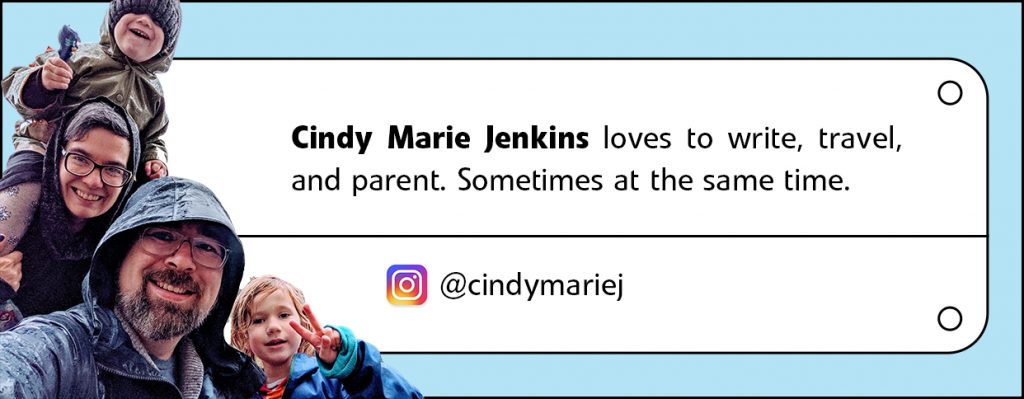I grew up with a wardrobe that fluctuated between princesses, Wonder Woman, and three-piece suits. I fit pretty easily into the tomboy category while playing softball, but also loved choosing a dress for my piano recital, so my family rarely cared. Still, I felt the judgemental looks whenever I leaned into my “Annie Hall” look of men’s wear. The morning I auditioned for drama school, I even rejected the two outfits I’d chosen and decided my father’s clothes were the way to go.
So it likely comes as no surprise that I don’t give a fig what my own kids want to wear, especially when they dress up for playtime.
My husband, Dan Jenkins, has never really been one for gender norms either, encouraging our first son to take ballet and yoga classes when he showed interest and laughing at his dress-up games, even when he chose princess outfits. Dan and I always shared household and parenting responsibilities, and it will surprise no one who knows us that we couldn’t care less who our children eventually want to date.
Yet there was one day in 2016 when our oldest was changing from his Rapunzel dress into a fairy outfit, and I asked Dan: “What if he wants to wear these outside the house one day?”
He was taken aback but didn’t really say anything. I tucked it away for a longer conversation later, one where we could discuss what would happen if kids made fun of him for it, and all the other justifications parents might give themselves for not allowing a child to play the way they want to play. I had run through them all in my head, and Dan deserved his own time to process the issue before we choose a joint parenting approach.
Fast forward: I woke up one Sunday morning in 2017 and read a Twitter thread from a clown that details what happened when a four-year-old boy in America asked her to paint a blue butterfly on his face. The Twitter user @boguspress tells the story like this (slightly edited for length):
Hey everyone I’m a clown and I just got back from facepainting at a picnic and here’s my take on male violence in America:
It starts young. And it’s more than just letting boys play with guns, it’s how we shame them for feeling anything that isn’t anger.
A 4yo boy asked me to paint a blue butterfly on his face. Then his mom told me “no, he doesn’t want that.”
“Butterflies are beuatiful, he said that’s what he wants, shouldn’t I paint what he wants?”
“No give him something for boys” She turns to dad, a big guy in a jersey, and says accusingly, “Do you want your son to have a butterfly on his face?” He says “No.”
Which, cool, let’s bring your husband’s masculinity into it too. Because your 4yo kids needs to know that his father would be ashamed too.
I really tried you guys, but this woman was so scared of her son wanting a butterfly she made me paint a skull and crossbones on his cheek.
I see this all the time. And I really feel for these boys, because the girls don’t get it as bad. Being a tomboy is slightly more normalized. And when girls want skills or sharks the parents shrug and laugh like “haha she’s a kooky kid!” because maleness and masculinity isn’t a sin. But when a boy wants to enjoy something for its beauty, they are told it’s not for them. Not in this house. Not in this family. We are teaching them that anger and violence are the only things they are allowed to experience. That to value beauty and elegance is shaneful.
I know that it was just facepaint, but that’s sort of my point. Why in the hell are these parents shaming their boys over FACEPAINT.
Think about what this four year old boy asked for
And what he got
This young boy’s own parents turned his desire to appreciate something beautiful, into the forced adoption of an image of violence and hate, effectively telling him not to embrace the way he feels unless it fits their – and society’s – image of masculinity. Blake Harper wrote on Fatherly at the time that “it’s a powerful example of how young boys are forced to embrace a certain personality that has been deemed acceptable by society. Whether or not it causes a child to act more violently, it certainly establishes the idea that aggressive symbols are inherently male.”
When I shared that with Dan, he thought back to my question and immediately realized that if he wouldn’t let our child wear a princess dress outside the house, he would be “an asshole just like those parents,” and vowed to never dictate what our children can wear based on outdated ideas of gender.
Fast forward again to 2018, and that same kid wants to grow his hair long. He’s been a little surfer kid ever since. Fast forward to 2019 and his little brother wears his Minnie Mouse glittered high heels to the playground, impressively scaling ladders and suspension bridges with ease.
Last Halloween, they chose their outfits on PandaBoo: one “archer” for our oldest and one bat for our youngest. I could see that he had chosen a girl’s bat outfit, but he scrolled through way more costumes than I would have had patience for, and that’s the one he wanted.
He played so happily in that costume for an hour, with a smile I honestly hadn’t seen on his face in ages. 2020 was a rough year, remember. But he was just beaming.
Until he danced in front of the window. It had gotten dark, so now he could see his own reflection: longish hair and this costume.
“Mommy?” he asked. “Do I look like a girl?”
The pain that dropped into my chest at that moment just gutted me. Not that he had made that distinction at just over four years old, but he sounded and looked so goddamn sad. He knew that if he looked “like a girl” then someone would say that to him, maybe even make fun of him for it. He knew. At four years old, he knew that crinoline skirts and headbands, paired with his long hair, could possibly get him mocked.
I tried to brush it off but he wouldn’t have it. “Do I look like a girl?” he insisted.
“You look like the happiest bat I’ve ever seen,” I said. “And if some people think you look like a girl bat, then it’s up to you to say yes or no. If you feel like a girl bat or a boy bat or just a purple bat, you tell them who you are. Or you can just smile and say thank you and not bother to correct them. Halloween is about what you want to be, not what other people think of you. Daddy and I will always stand by you.”
I have no idea if that was the right thing to say. It felt like the best thing to say, or “the next right thing,” as Anna in “Frozen II” would say.
So it is that in 2021, we find ourselves sending Steve from “Minecraft” and Pinkie Pie from “My Little Pony” off to Storybook Day at their school. 
If anyone at school said anything to them, I didn’t hear about it. I considered sending a message to the teachers, but then I remembered that they’ve always been in full support of my son’s quirky style, and I had no reason to believe otherwise for this day.
You know, adults and kids comment on our kids’ long hair all the time. Part of why I keep my hair shaved and short is because they like that their mom has short hair, and it’s an easy thing they can point to when their friends say that “long hair is for girls.”
Who knows if our kids will continue their gender-nonconforming dress-up or not? Who cares? Today it’s all Zelda and Super Mario, and tomorrow it’s “My Little Pony“ and “True: Happy Hearts Day.” Their playtime should be about their imagination and joy. Who are we to police that?
KEEP READING: Daddy or Doula? Should Fathers Witness Childbirth?
Images: Cindy Marie Jenkins







